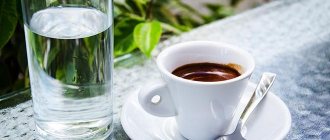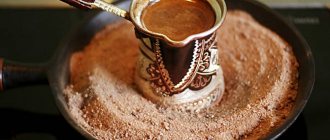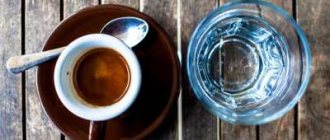Enjoy your coffee!
There is always room for experimentation - try different grains, change the grind size, add clear juices - apple or cherry - to the water. Try adding coffee to the top flask immediately after raising a small amount of water, wait until the water has completely risen, remove the burner and place a few ice cubes or frozen fruit slices in the top flask to stop the brewing process.
Life hack: A siphon is also an excellent device for brewing not only coffee, but also tea; try brewing Pu-erh in it, and you will get an excellent tea drink.
Read our articles about how to make coffee in other coffee gadgets.
“Second life” of the coffee siphon
Coffee siphons were quite popular at the beginning of the 20th century. In the USA, they invented and patented a mechanism that turns off the alcohol burner in coffee pots, similar to Madame Vassier’s siphon. Coffee makers of this design were produced by the American company Silex.
With the invention of fire-resistant glass, many countries began to produce not only balance siphons, but also vertical siphons, which also began to be called gabettes. These gabets differed from their predecessors in the 19th century only in their greater strength and the presence of a seal between the upper and lower vessels. Over time, the alcohol burner was replaced by an electric heater. In the USSR, vertical electrogabetes were manufactured back in the 50–60s of the 20th century (Fig. 4).
Fig.4. Soviet electric gabet of the mid-20th century
But due to the popularity of instant coffee, gabets gradually went out of use. Then humanity became interested in espresso, and only at the beginning of the 21st century, when alternative methods of brewing coffee came into fashion, did they remember about gabets again.
Now balanced and vertical siphons for making coffee are produced by the companies Hario, Cona, Bodum, Yama. There are also souvenir models with alcohol burners and vertical siphons with gas burners on sale (Fig. 5). Vertical gabits with infrared heaters look very impressive (Fig. 6).
Fig.5. Vertical gabet with gas burner
Fig.6. Gabet with infrared heating element
Advantages and disadvantages
Gabet has a number of advantages and disadvantages. Among the positive aspects are:
- the prepared drink is characterized by excellent taste;
- ease of operation;
- the spectacle of the brewing process itself;
- versatility. The siphon is suitable for making coffee, tea, herbal infusions.
Among the disadvantages of the device:
- fragility;
- open fire;
- the burner must be refilled regularly;
- price.
What is a siphon (vacuum) coffee maker?
The siphon coffee maker is an intriguing piece that looks like something out of a high school chemistry lab.
You may have noticed this device on the shelves in some trendy coffee shops. Only you probably didn’t know what it was. Now let's figure it out...
A siphon coffee maker is a complete immersion coffee brewing system.
The first chamber of the system uses a heating element to create a vacuum in one chamber. This occurs due to water entering the upper chamber.
Hot water washes over the ground coffee, and the drink then flows into the lower chamber.
Design
To quickly understand how such a useful and functional device works, you need to familiarize yourself with its design. I must say that it is not the most difficult. Of course, over time it was seriously modernized, but its main “units” still remained the same. A siphon for tea and coffee consists of such elements.
- The glass flask at the bottom. This vessel is usually round or teardrop-shaped. It is made from a reliable heat-resistant material that is not afraid of high liquid temperatures.
- Metal tripod. The lower vessel is attached to it so that there is free space for the heating element to be located.
- Upper flask. This component is usually made of glass. Most often it has a cylindrical shape, a little less often - spherical. In the lower part, the indicated container is complemented by a fairly long tube. Once the device is assembled, it will need to reach the very bottom of the bottom heat-resistant container.
- The device also has a lid.
- Rubber seal located between the flasks.
- Filter with small cells. It is usually located on the top tank. It is made either from metal or fabric.
- Heating source. Basically, this function is performed by a simple alcohol burner. But modern experienced baristas more often use specialized models with a gas burner. They are often an integral component of the kit of some models of modern siphons. The main advantage of such devices is that with them it is possible to more accurately regulate the heating under different drink preparation modes.
A little history
A patent for it was issued in Berlin in 1830, but at the same time the French offered a number of their own versions of the siphon. The name, by the way, comes from the surname of the Frenchman Louis Gabet.
In subsequent years, the device was repeatedly improved. For example, the Japanese used this device in making tea.
Where to buy and how much does a coffee siphon cost?
You can purchase a siphon in specialized coffee accessories stores or on the Internet.
- A wide range of siphons is produced by the Japanese company Hario. The advantage of these devices for private consumers is that they have small volumes. Many models are 300 or 400 ml, which is enough for two cups of drink. A 300 ml device can be found for 3,000 rubles, but more often the price tags of this manufacturer are much higher, especially for new products or original designs. New generation 600 ml siphons can cost from 9 to 15 thousand rubles.
- The stores have many offers from Chinese manufacturers; they are attractive with their pricing policy. A 600 ml device costs 3500-4000 rubles.
- For those who are not ready to tinker with burners and open fire, an electric siphon was invented; it costs 6-7 thousand with a volume of 360-400 ml.
- Connoisseurs of unusual design will appreciate retro-looking devices, with two tanks located side by side and connected by a pipe system. They look very picturesque. The cost of such a miracle of technology is 7-9 thousand for a volume of 350-400 ml.
In some stores, siphons are sold under the label “for tea”. Don’t let this confuse you, the device is used to prepare both types of drinks.
What is the advantage of a vacuum (siphon) coffee maker?
The beauty of the siphon method comes from 4 main elements.
Full immersion
You may know that full immersion means that the ground coffee and water are in contact throughout the entire brewing process. Similarly, coffee is prepared in an AeroPress and a French Press.
Full immersion brewing typically produces a light, clean-tasting coffee.
Vacuum
After the ground coffee sits in the hot water for a while, a vacuum created in the lower chamber draws the coffee-rich liquid down through the filter. Thanks to this technique, all the oils (and therefore the taste) of the coffee are captured.
The result is a cup of coffee with a stunningly pure aroma. It will contain all the nuances of flavor from your favorite grind.
Sequential heating
Many coffee brewing methods require the use of preheated water that is poured into the ground coffee. In a siphon coffee maker, water is heated gradually.
As you know, temperature is an important factor affecting the quality of the final drink. If the heating is gradual, you can better control the quality and taste of your coffee.
Aesthetic and intriguing appearance
Strictly speaking, the appearance of the device will not affect the result in any way. Still, it is worth admitting that the siphon standing in your kitchen will definitely impress your guests.
Let's look at the 5 best siphon coffee makers. Later we will discuss in more detail how exactly to choose such a device.
History of the siphon for carbonating water
Natural carbonated waters from volcanic springs have been valued at all times for their unique properties. Effervescent natural water was considered a natural tonic. The soothing effects of effervescent waters have made them a popular treatment for indigestion. True, storing and transporting such mineral waters was a costly endeavor. Basically, you could only buy it in pharmacies. The lack of side effects from a glass of carbonated water, unlike many other drugs of the time, motivated scientists to find ways to create artificial analogues of soda.
The English chemist Joseph Priestley was the first to create artificial carbonated water in 1767. The scientist conducted experiments with the gas that was released during the fermentation of beer. In one of his experiments, he saturated clean water with carbon dioxide. At the same time, the water began to hiss and release many bubbles to the surface. His research was described in the book “Impregnation of Water with Still Air” in 1772.
In 1770, a colleague from Sweden, Thorbern Bergman, invented a saturator - a “saturator” of water with carbon dioxide.
In 1783, a native of Germany, Johann Jacob Schweppe, improved the device, after which he put the production of carbonated water on stream.
At the turn of the 19th century, scientists continued to experiment with methods of gassing water to achieve maximum effect, until the Englishman Charles Plint invented the siphon in 1813. This device made it possible to dose portions while keeping the water carbonated. But the siphons had to be filled in places equipped for these purposes. In 1832, British inventor John Matthews solved this problem. He created a device for artificial carbonation in quantities necessary for pharmacies and trade. Matthews's design was simple but practical. The apparatus consisted of a lead-lined chamber in which sulfuric acid was mixed with calcium carbonate to produce carbon dioxide. The gas was purified and sent to a tank of cold water, then it was shaken so that the gas dissolved in the water and sent through pipes to a dosing tap. The process of making carbonated water was unsafe. At first, the devices exploded due to imperfect design and unreliable equipment. Over time, the system was improved and made safe. Purified CO2 was supplied in cylinders ready to be dissolved in water.
Everyone remembers very well the sale of sparkling water, bottled in glass bottles and sold in retail chains. The peak was between the 1920s and 1930s, when most siphons were made from Czech glass. Today, siphons from this era can only be found in antique stores.
In the 1950s, a home model was released, which was still quite large and unaffordable for most families.
The popularity of soda fountains began to decline in the late 1980s, as drinks packaged in bottles and cans became available for sale in large quantities. But such a product raised concerns; few people knew how these drinks were produced on an industrial scale and what was added to them. Soda siphons are back in everyday life again. Homemade sparkling water did not raise these concerns.
Currently, you can buy siphons of different types in stores - made of plastic or stainless steel. A stainless steel device is considered more reliable and looks more aesthetically pleasing. Modern siphons are safe; they have a special valve that will prevent the device from bursting due to high pressure.
Principle of operation
The device works according to the following principle:
- Water is poured into the lower reservoir.
- A heater is placed under the flask.
- When a liquid boils, it expands and turns into a gaseous state. At the same time, the pressure in the flask increases.
- Water begins to move along the column from the lower reservoir to the upper one.
- The optimal temperature for extraction is created at the top.
- Coffee is poured in there.
- The mixture is infused for a short time, after which the heating is turned off.
- The molecules of the liquid begin to change from a gaseous state to a liquid state.
- The pressure decreases and a vacuum is formed.
- The finished drink moves through the filter into the lower container.
How does a modern version of a coffee siphon work?
The design of the device is quite simple, it has been improved over the years, but the general idea remains the same.
- The lower flask is made of glass, of course, heat-resistant. It has a round or drop-shaped shape.
- A metal stand to which the lower flask is attached. Below, under the glass vessel, there is space for the heating element.
- The top part is a second borosilicate glass flask. It can have a cylindrical or spherical shape, and must be equipped with a long tube at the bottom. When the structure is assembled, this tube reaches almost to the bottom of the first flask.
- Cover for the upper reservoir.
- Rubber gasket between flasks.
- A fine mesh filter is placed in the upper vessel. It can be textile or metal.
- A heating element. An alcohol burner most often serves in this capacity.
Many baristas prefer to use a special gas burner rather than the alcohol lamp that comes with most siphons. The gas heater is sensitive to adjustment; you can increase or decrease the heating speed by choosing different modes for preparing the drink.
What can you cook in a siphon?
The tea siphon can be used for more than just standard tea or coffee preparation. Oolongs, puerhs and hibiscus are best brewed in this device.
You can also prepare a variety of tea cocktails, during the preparation of which all components are mixed immediately before brewing in a siphon flask from above. Tea siphons are ideally suited for preparing tea with aromatic herbs, such as thyme, linden or mint, because the aroma is extracted from the raw materials in a special way. This tea comes out with an incredible, new sound. Be sure to compare the prepared drink in a kettle and in a siphon, and, most likely, you will like the latter much more.
And finally, the main advantage of the siphon is the ability to experiment with different teas and other ingredients.
Source
Brewing coffee in a gabette
Gabet is an excellent tool for experimenting with making black coffee. With this brewing method, the refined taste of elite single-origin coffees is well demonstrated, but inexpensive blends of 100% Arabica beans are also suitable. An exotic drink with an unusual taste is made from a mixture of Arabica coffee with 20–25% excelsa.
Robusta adds bitterness to coffee. Only fans of very strong coffee like to brew robusta in a gabette. But even in this case, it is undesirable for Robusta to be more than 20%.
Any degree of roasting is allowed, grinding is medium or fine (but not dusty). If the beans are ground too coarsely, the taste of the drink will not be rich enough.
To brew coffee in a siphon, you need soft bottled water with a mineralization of 75 to 250 mg/l.
To obtain coffee of moderate strength, take 26 g of freshly ground beans per 360 ml of water (at the rate of 7.2 g of ground coffee per 100 ml of water).
Making coffee in a vertical rack
- Place the filter on the bottom of the upper vessel, level it and secure it (in many models, the filter is attached to the lower edge of the tube using a chain with a hook).
- Pour water into the lower vessel.
- Turn on heating.
- Place the upper vessel with the tube on the lower one.
- After the water boils in the lower vessel, pour coffee into the upper one.
- Water will begin to flow into the upper vessel. Gently stir the coffee. Brewing lasts 1 minute 10 seconds.
- Turn off the burner or heating element. Stir the coffee until the liquid is absorbed into the lower vessel.
Safety regulations
When using a siphon, you must adhere to the following safety rules:
- Do not touch glass tanks with bare hands. You need to use fabric gloves or oven mitts;
- Durable glass is used to make the flasks, but the risk that it will break still remains . Therefore, tanks must be handled with care;
- The burner should be refueled away from fire sources and heating devices. Perform these steps only after the heating element has completely cooled down;
- It is strictly prohibited to heat the gabette for more than ten minutes. The lower reservoir may burst.










